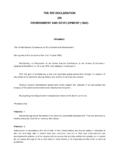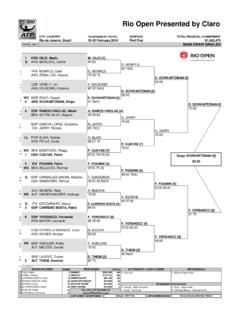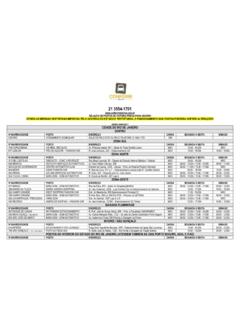Transcription of Structural Analysis of Guyed Steel Telecommunication ...
1 Structural Analysis of Guyed Steel Telecommunication Towers for .. J. of the Braz. Soc. of Mech. Sci. & Eng. Copyright 2007 by ABCM April-June 2007, Vol. XXIX, No. 2 / 185 Marcel Isandro R. de Oliveira Universidade do Estado do Rio de Janeiro - UERJ Programa de P s-Gradua o em Engenharia Civil Jos Guilherme S. da Silva Member, ABCM Pedro Colmar G. da S. Vellasco Member, ABCM Universidade do Estado do Rio de Janeiro - UERJ Departamento de Engenharia Mec nica 20550-900 Rio de Janeiro, RJ. Brazil Sebasti o Arthur L. de Andrade Deprtamento de Engenharia Civil, PUC-RJ 22453-900 Rio de Janeiro, RJ. Brazil Luciano R. O. de Lima Universidade do Estado do Rio de Janeiro - UERJ Departamento de Estruturas e Funda es Structural Analysis of Guyed Steel Telecommunication Towers for Radio Antennas The usual Structural Analysis models for Telecommunication and transmission Steel tower design tend to assume a simple truss behaviour where all the Steel connections are considered hinged.
2 Despite this fact, the most commonly used tower geometries possess Structural mechanisms that could compromise the assumed Structural behaviour. A possible explanation for the structure stability is related to the connections semi-rigid response instead of the initially assumed pinned behaviour. This paper proposes an alternative Structural Analysis modelling strategy for Guyed Steel towers design, considering all the actual Structural forces and moments, by using three-dimensional beam and truss finite elements. Comparisons of the above mentioned design models with a third alternative, that models the main structure and the bracing system with 3D beam finite elements, are made for three existing Guyed Steel Telecommunication towers (50m, 70m and 90m high).
3 The comparisons are initially based on the towers static and dynamic Structural behaviour later to be followed by a linear buckling Analysis to determine the influence of the various modelling strategies on the tower stability behaviour. Keywords: Telecommunication and transmission towers, Guyed Steel structures, spatial structures, Structural Analysis , computational modelling, modal Analysis , stability Analysis . Introduction The Brazilian Telecommunication and electrical power transmission systems expansion were the main reasons for efficient and cost-effective transmission and Telecommunication Steel towers. Steel truss towers have been used to support transmission antennas or to enable electrical power transmission lines to be built, interconnecting the vast Brazilian territory.
4 However, Structural collapses, mainly associated with the wind action, are not uncommon to this particular Structural solution (Blessmann, 2001; Carril J nior 2000).1 Despite these facts, most of the traditional Structural Analysis methods for Telecommunication and transmission Steel towers still assume a simple truss behaviour, where all connections are considered hinged. On the other hand, Structural mechanisms, that could compromise the assumed Structural response, can be present in various commonly used tower geometries whenever truss type models are adopted (Policani 2000, 2000a; Silva et al. 2000, 2002). A usual solution to overcome this problem is the use of dummy Structural bars to prevent the occurrence of the unwanted degrees of freedom.
5 These bars, possessing a small axial stiffness, are generally employed to prevent the occurrence of Structural mechanisms, enabling the use of standard finite element programs. A possible explanation for the structure stability is related to the semi-rigid, instead of the assumed hinged joint behaviour. In fact, most major Steel tower constructors still rely on full-scale tests to determine which design and fabrication details can provide a good test correlation with the assumed simple truss model results. Paper accepted April, 2006. Technical Editor: Marcelo A. Savi. This paper proposes an alternative Structural Analysis modelling strategy, based on a less conservative model combining 3D beam finite elements in the main structure and 3D truss elements in the bracing system and eliminating the use of dummy bars present in the traditional Analysis .
6 Further comparisons of the two above mentioned methods and another design alternative only using 3D beam finite elements on three existing Guyed Steel Telecommunication towers (50m, 70m and 90m high) are described. The comparison is focused on the tower Structural response in terms of displacements, bending moments, stresses, natural frequencies and buckling loads. Nomenclature max = Maximum stress of the tower; umax = Maximum horizontal displacements of the tower f01 = First natural frequency of the tower, f02 = Second natural frequency of the tower, f03 = Third natural frequency of the tower, f04 = Fourth natural frequency of the tower, f05 = Fifth natural frequency of the tower, 01 = First buckling load of the tower, 02 = Second buckling load of the tower, 03 = Third buckling load of the tower, 04 = Fourth buckling load of the tower, 05 = Fifth buckling load of the tower, The Structural Modelling Several authors have contributed with theoretical and experimental investigations to access the best modelling strategy for Steel transmission and Telecommunication towers.
7 It is fair to Marcel Isandro R. de Oliveira et al 186 / Vol. XXIX, No. 2, April-June 2007 ABCM mention the investigations made by: Albermani and Kitipornchai 1993 and 2003; Albermani et al 2004; Carril J nior 2000; El-Ghazaly and Al-Khaiat 1995; Kahla 1994 and 2000, Kitipornchai and Albermani 1992; Madugula and Wahba 1998; Menin 2002, Rao and Kalyanaraman 2001; Saxena et al 1989; Wahba et al 1996 and Wahba et al 1998. Kahla 1994, numerically modelled the dynamical effects present in Guyed Steel towers including the cable galloping effects. Later the same author, Kahla 2000, dynamically modelled the rupture of a cable present in Guyed Steel towers. The Analysis indicated that the Guyed Steel towers cable rupture, disregarding the wind actions, was one of the most severe critical load hypotheses for the investigated structures.
8 Wahba et al 1996, considered the dynamical nature of the load acting in Guyed Steel towers like wind, earthquakes and cable gallop. The finite element method was used to model the tower bars as 3D truss and 3D beam elements obtaining the Structural models dynamical characteristics. In a subsequent phase these results were compared to experiments. This paper also described the results of experiments made to identify the main parameters that influence the Guyed Steel towers natural frequencies, as well as, their and associated vibration modes. Ghazalyt and Khaiatz 1995, evaluated Telecommunication Guyed Steel tower designs based on discussions of the various non-linear aspects involved on their numerical modelling.
9 This paper also contemplated the development and comparisons of the results of a 3D model for a 600 meter height Guyed Steel tower. Wahba et al 1998, performed an investigation of the numerical models used in Telecommunication Guyed Steel towers. The authors stressed the relevance of considering the non-linear effects present even at service load levels. In a subsequent paper, Madugula and Wahba 1998, described two different finite element models for the dynamical simulation of Guyed Steel towers. This paper also contemplated an experimental modal Analysis of reduced-scale Guyed Steel towers models that produced results in consonance with the developed numerical models.
10 Menin 2002, evaluated Telecommunication Guyed Steel towers from their static and dynamical Structural responses. The static Analysis compared linear and non-linear mathematical models. The dynamical Analysis employed the Monte Carlo simulation method including the wind load floating parcel producing interesting results. Albermani and Kitipornchai 2003, used the finite element method by means of a geometrical and physical non-linear Analysis to simulate the Structural response of Telecommunication and transmission Steel towers. This was followed by a later work of Albermani et al 2004, that investigated the possibility of strengthening Steel truss towers from a restructure and rearrangement of their bracing systems.


















